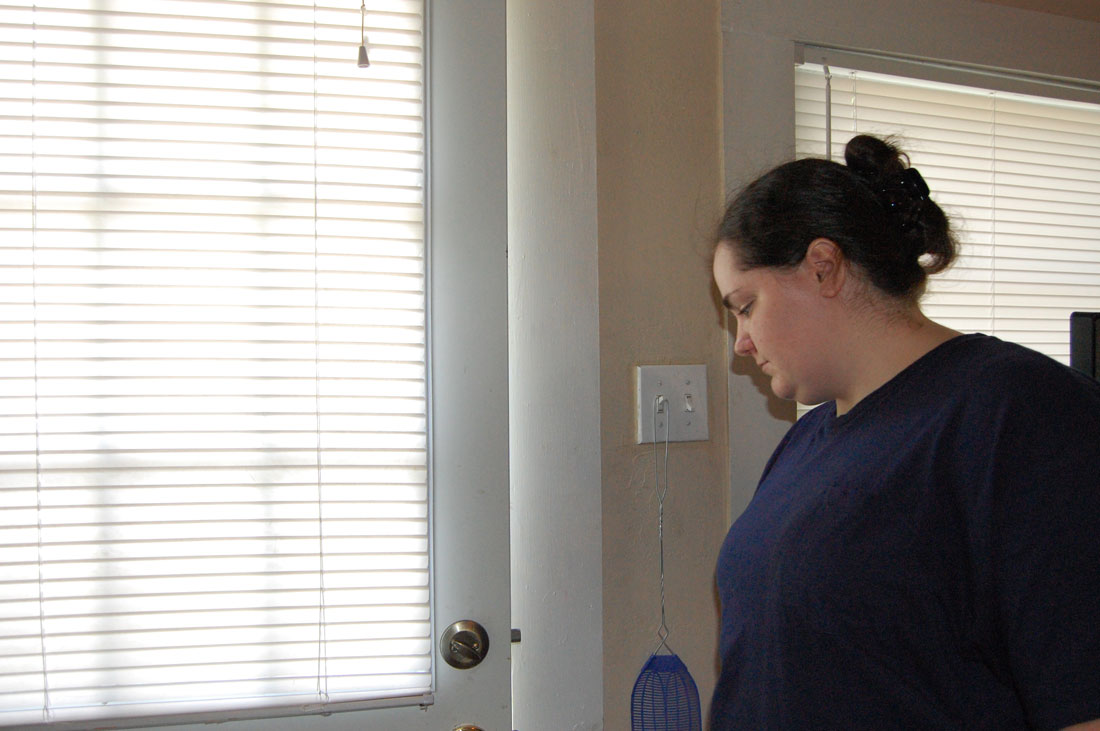A window that’s popped out of its frame allows spiders to creep into Keary and Kristina Rosalez’ Cleburne home. New cracks about six inches long are visible in the shower and along the bathroom counter. More cracks run along walls that had been remodeled before the couple moved in less than two years ago.
Those damages occurred when an earthquake measuring 3.6 on the Richter scale rattled the home on June 24. Now the front door won’t properly lock because the foundation has been damaged on one side of the house, Kristina said.
The Rosalezes didn’t know what was happening when they felt the strongest earthquake recorded in Johnson County’s history. The couple were watching TV in their living room when they felt the house shake and the television lost its signal.
“I want to know what’s causing them. We went years without any kind of earthquake. Then in a month we have seven earthquakes out of nowhere,” Kristina said. “And they’re causing damages that can be costly.”
The June 24 earthquake was one in a string of nine quakes that began that month. Since January, 10 earthquakes have been recorded in Johnson County, and scientists from the U.S. Geological Survey believe they may be connected to injection wells used by the gas drilling industry to dispose of highly toxic waste liquids from hydraulic fracturing.
According to the most recent report from the Texas Railroad Commission, 14 injection wells are located in Johnson County, compared to four each in Tarrant and Ellis counties, two in Denton County and none in Dallas County.
Nine of the Johnson County wells are within a 10-mile radius of downtown Cleburne. This year, four earthquakes were recorded in that radius and four were less than five miles outside of the radius. Law enforcement agencies received no reports of injuries.
Before 2009 Johnson County had never recorded an earthquake. That year there were four temblors in June and one in September, all measuring less than 3.0. One quake was reported in the County in 2010, at 2.5 strength, and one in 2011, at 3.0. (On the Richter scale each whole-number increase indicates a quake 10 times stronger than the last number.)
USGS research geophysicist William Ellsworth said he doubts the quakes will become significantly stronger, but noted that they are becoming intense enough to cause structural damage, as evidenced by the Rosalez house.
“Typically if you have 10 earthquakes of a magnitude 2, you can expect one of magnitude 3 and so on,” Ellsworth said. “Only a few are problematic. It’s a matter of identifying problems before they are out of hand.”
Johnson County’s rise in felt earthquakes is part of a national phenomenon. USGS researchers, led by Ellsworth, have concluded that the average number of quakes in the nation’s midsection — Colorado, Texas, Arkansas, Oklahoma, and Ohio — has multiplied sixfold since 2001.
“In some very specific cases, we can make a connection between wastewater disposal [wells] and seismic activity,” Ellsworth said. He stressed that it is not the gas well fracking that is linked to quakes.
Four injection wells were shut down in northeast Ohio after a 4.0 quake rattled a small village outside of Youngstown last December. It was the 11th and strongest in a series of earthquakes in the area. None of the earlier quakes registered stronger than 2.7.
Cliff Frohlich, senior research scientist and associate director of the Institute of Geophysics at the University of Texas at Austin, has studied seismic activity in Johnson County since 2008, and he too has found evidence suggesting they are linked to disposal wells.
Frohlich was part of a team of seismologists from UT and Southern Methodist University that explored the causes of a 2009 earthquake near Dallas/Fort Worth International Airport. They found that a well at the southern end of the airport property was very close to a major fault.
Chesapeake Energy shut down that well and another in south Cleburne. There are now three active disposal wells in Cleburne.
Frohlich found that the epicenters of these quakes are relatively close to the wells’ location. “My studies do show the majority of earthquakes in Johnson County since 2008 are within five or 10 kilometers of at least one injection well,” he said.
Although the Johnson County quakes have been relatively weak, they are not free of danger. Frohlich said that it’s possible — though unlikely — that they could damage pipelines installed on top of a fault.
“Pipeline operators are supposed to think of the possible risks when installing pipelines. I don’t think they considered earthquakes in Texas,” said Carl Weimer, executive director of the Pipeline Safety Trust, a nonprofit organization that advocates for safe fuel transportation.
Pipelines can be engineered to take into account stresses such as the ground movements caused by earthquakes and landslides. Weimer said he doubts Texas pipelines are engineered that way since Texas has historically not experienced earthquakes.
One Johnson County resident, who asked not to be named, doesn’t buy the connection between the drilling industry and quakes. The self-proclaimed history and science freak has worked for oil and gas companies since 2006 and has lived in the county for 20 years. He said he has felt all along that it was only a matter of time before the faults in the area became active.
“It finally decided it wants to wake up. And it’s just getting started,” he said.
Before moving to Johnson County, he worked in the oil fields in West Texas, where he said he never experienced an earthquake.
The Texas Railroad Commission also denies any links between disposal wells and earthquakes in Johnson County. “Commission staff have no science or data at this time linking these minor seismic events to oilfield activities. With more than 30,000 injection and disposal wells, Texas has a long history of safe injection, and Railroad Commission staff has not identified a significant correlation between seismic activity and injection practices,” Railroad Commission spokeswoman Ramona Nye wrote in an e-mail.
David Hayes, deputy secretary of the U.S. Department of Interior wrote in a blog recently that of approximately 150,000 injection wells in the U.S., “Only a tiny fraction of these disposal wells have induced earthquakes that are large enough to be of concern to the public.”
Ellsworth and the USGS team are trying to learn more about the relationship between the wells and quakes in order to predict when quakes will occur and how strong they will become.
Frohlich said he expects minor earthquakes to continue in this region as long as the Barnett Shale continues to be developed.
The Dallas Morning News cited the Johnson County earthquakes in an editorial in June urging a ban on injection wells in that city.
Disposal wells have been banned in Fort Worth since 2006. Until this year, they were covered by a moratorium that was extended several times. But on April 30 the city council made the ban permanent in the face of concerns raised by groups such as the North Fort Worth Alliance and the Fort Worth League of Neighborhood Associations.
Frohlich said he doubts earthquakes in Johnson County will reach magnitudes that cause great damage.
“My sense is, little earthquakes are not a bad thing. From my point of view, they’re kind of fun,” he said.














At first I was concerned about the lack of comments on this story, and then it bacame clear. The level of ignorance and denial from the Texas Railroad Commission and our local elected officials concerning the negative impacts of shale gas drilling and production….toxic injection wells included….just leaves one speachless! “Little earthquakes are fun!”
What a compete Dumb Ass remark! What’s next, “Oh yea, it’s a gas well fire, but break out the steaks and ribs. It’s a BBQ opportunity as well!” (shaking his head in utter disbelief)
You just gotta laugh at Texas.